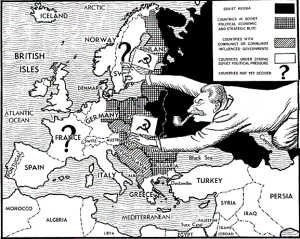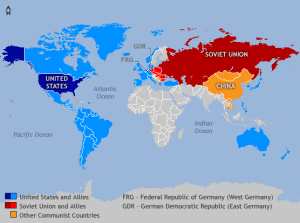There are parts of the American survey that are overwhelming. How is it possible to teach any major conflict (Revolutionary War, Civil War, WWI or WWII, Vietnam) or even minor scuffles in one or two weeks? How is it possible to capture intellectual, social, cultural, environmental, economic, political, and/or military histories surrounding certain events in a brief “overview?” Isn’t it always the “trivia” of history that makes it so exciting and expansive? For example, the Worlds’ Fairs in Chicago or the evolution of Jazz and Blues music in the South/North are an endless source of inquiry – there are times I wish I could “just” focus on something like that for the rest of the term.
In teaching the second half of the survey, it seems increasingly difficult for students to contextualize (apparently) distant events like the Cold War. Although finding the humor and political saliency of Natasha and Boris’ oafish covert tactics in Rocky and Bullwinkle, or even advertisements from the 1980s to be readily accessible; and while we clearly still experience polarizing political and economic motivations in a globalized arena, it seems more and more that fear of “the bomb” or the practice of brinksmanship falls into cobweb-infested corners of collective consciousness.
But, isn’t that what makes our teaching of history exciting? Part of the historian’s craft is having to re-chronicle and re-contextualize, even by encouraging our (ahem) young(-ish?) students to start up conversations with their parents about memories of historical events and phenomena. I re-discovered (again) this term that I am the only person in the room who wanted a bomb shelter as a kid. Despite my advanced age of 43, I remain alert to the fact that we know history to not be self-executing: we simply can’t put in a few keywords into a search engine and have “history” appear before our eyes. In dealing with the Cold War especially, conveying any essence of the “true” past is difficult – moving from the sense of global involvement and engagement of WWII to collective paralysis, from utter fascination to dizzying fear of science and scientific discoveries, from the conflicting political ideologies (each with their own set of internal contradictions) to divisive land-taking/holding strategies, we simply can’t take the chaos and personalities and events and reconstruct them to represent what “really” happened. I am reminded of Emerson’s essay on Art, where he writes:
“No man can quite emancipate himself from his age and country, or produce a model in which the education, the religion, the politics, usages, and arts, of his times shall have no share. Though he were never so original, never so willful and fantastic, he cannot wipe out of his work every trace of the thoughts amidst which it grew…Above his will, and out of his sight, he is necessitated, by the air he breathes, and the idea on which he and his contemporaries live and toil, to share the manner of his times, without knowing what that manner is.”
Not only is it a struggle to cover the important aspects of major events that permanently alter our world, it is a struggle to craft its retelling: which primary sources are helpful? Which events or persons will best illuminate the tensions of the time? What did I carelessly leave out last time I taught the course? Will I make too many jokes about the Soviets? (How can I resist lines like: “In America, you can always find a party. In the Soviet Union, the Party can always find you!!”)
I have, in fact begun to use the political cartoon as a primary source for bona-fide reaction papers. I particularly enjoy this one:
Bias, point of view, historical specificity and context are all readily available to students (*I think*), as are the larger implications and/or foreign policy directives (and domestic agendas).
As we march through the survey, and toward the end of the academic year, what strategies do you use to effectively teach these “big bangs” that 20th century brings?



Good question. Teaching Cold War in World History, these days. Not US. I start general (Iron Curtain, containment, Marshall Plan) and then have them compare and contrast US interventions. I try to focus on two distant case studies: Vietnam and Afghanistan. Or Iran and Guatemala. And then zoom back out to the big picture. Maybe use Cuba and Berlin as another pair to contrast methods of indirect conflict, or to compare/contrast outcomes. But as much of the time as possible, avoid strictly abstract/ideological content. Always grounded in real places, made memorable with stories of escapes from East Berlin, etc. And I emphasize skills over content, anyway, so I have made my peace with leaving out content. SALT, space race, South Asia, etc. get short shrift by me.
And of course, tell kids honestly that what we are doing is a survey/intro. Give them enough to know something Cold War-related when they see it later.
PS Where did you get the Stalin cartoon? Year?